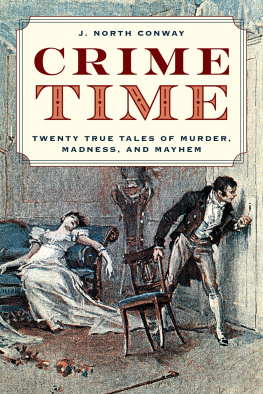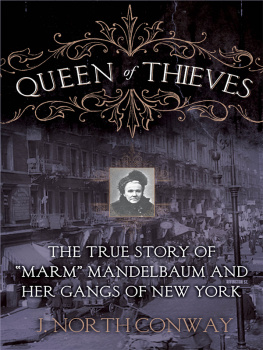Also by J. North Conway:
Kings of Heists
The Big Policeman
Bag of Bones
Attack of the HMS Nimrod: Wareham and the War of 1812
The Weather Outside is Frightful
The Cape Cod Canal: Breaking Through the Bared and Bended Arm
Shipwrecks of New England
New England Visionaries
New England Women of Substance
American Literacy: Fifty Books That Define Our Culture and Ourselves
From Coup to Nuts: A Revolutionary Cookbook
Copyright 2014 by J. North Conway
All rights reserved. No part of this book may be reproduced in any manner without the express written consent of the publisher, except in the case of brief excerpts in critical reviews or articles. All inquiries should be addressed to Skyhorse Publishing, 307 West 36th Street, 11th Floor, New York, NY 10018.
Skyhorse Publishing books may be purchased in bulk at special discounts for sales promotion, corporate gifts, fund-raising, or educational purposes. Special editions can also be created to specifications. For details, contact the Special Sales Department, Skyhorse Publishing, 307 West 36th Street, 11th Floor, New York, NY 10018 or .
Skyhorse and Skyhorse Publishing are registered trademarks of Skyhorse Publishing, Inc., a Delaware corporation.
Visit our website at www.skyhorsepublishing.com.
10 9 8 7 6 5 4 3 2 1
Library of Congress Cataloging-in-Publication Data is available on file.
Cover design by Anthony Morais
Cover photo credit Library of Congress
Print ISBN: 978-1-62914-435-1
Ebook ISBN: 978-1-63220-098-3
Printed in the United States of America
This book is dedicated to my wife, Julia, who is the real Queen among Thieves for stealing my heart so long ago.
A QUEEN AMONG THIEVES
MOTHER MANDELBAUMS VAST BUSINESS.
BUYING STOLEN SILKS BY THE THOUSAND YARDSDEPOTS IN MANY CITIESBLACKMAILING DETECTIVES.
IN NEW-YORK CITY there are not over eight or nine men and women who are known as professional receivers of stolen goods. First in the list and standing at the head of the country as the largest dealer was Mrs. Fredericka Mandelbaum...
New York Times, July 24, 1884
CONTENTS
A Mingled Yarn
In which Fredericka Mandelbaum arrives in America in 1850 and settles with her family in Kleindeutschland (Little Germany) on New York Citys Lower East Side.
In which Mandelbaum learns the ins and outs of the fencing business from some of the countrys best criminals.
In which her fencing business flourishes in New York City because of the corrupt police department and politicians and the shoddy aristocracy prospers.
In which Mandelbaum breaks Piano Charlie Bullard out of jail and he and Adam Worth flee to Europe where they meet an undesirable end.
In which Mandelbaum makes the acquaintance of George Leslie, who revolutionizes the bank robbery business and pulls off the biggest heist in history.
In which Sophie Lyons rises to the heights of criminal infamy under the tutelage of Mandelbaum and later disavows her criminal life claiming crime doesnt pay.
In which following a civil suit, Mandelbaum is apprehended by Pinkerton detectives, taken to court and a bail hearing is held.
In which Mandelbaum gets her day in court and voices her innocence.
In which the New York City Police Department and the district attorneys office engage in a public clash.
In which Mandelbaum outsmarts Pinkerton detectives and flees to Canada.
In which Mandelbaum slips back into New York for her daughters funeral and lives out her final days in Canada.
In which we learn the fate of several prominent characters.
Fredericka Mandelbaum achieved a significant level of power and success as a criminal entrepreneur and became an important figure in the contemporary narrative of crime. She achieved what she did because (not in spite) of the time and place in which she used her talents.
Rona Holub, scholar and author, 2007
Introduction
A MINGLED YARN
The web of our life is of a mingled yarn, good and ill together.
William Shakespeare, Alls Well That Ends Well
F redericka Mandelbaum, a German-Jewish immigrant, became the most influential crime figure in New York City during the Gilded Age, accumulating more money and power than any woman of her era at a level inconceivable for any women engaged in any legitimate business. As the countrys premier fence (receiver of stolen property), she became the head of one of the countrys first organized crime rings. Hailed by the New York press as Queen among Thieves she was a driving force behind New York Citys festering underworld for more than twenty-five years.
A July 1884 New York Times article called her the nucleus and center of the whole organization of crime in New York City. Her lengthy reign was enabled by both a corrupt New York City police department and an unscrupulous political and judicial system. But it was her cunning intellect and association with the best criminal minds in the city that allowed her to attain such prominence. The engine that drove her to the top of her criminal profession was fueled by her devotion to her family as well as the crime family she surrounded herself with: her own family because she loved and cherished them and her crime family because they were the source of her wealth and power. Her immersion into a life of crime, as opposed to one of legitimacy, was a backlash against the cruel treatment she and her husband had endured at the hands of German authorities before being forced to immigrate to America. That abuse and distrust of authority kept her on the wrong side of the law throughout her life. She also had the keen realization that a woman, no less a Jewish woman facing all the native prejudices of the era, could never find acceptability or the kind of wealth and power she attained in any legitimate business.
Mandelbaum immigrated to New York City from Germany in 1850 with her husband, who was a peddler, and her first child, after German authorities imposed a series of laws restricting travel and trade by those of the Jewish persuasion. She began her climb to the top of the crime world in America as a peddler on the rough-and-tumble, bustling streets of the city. Because of her height (she was close to six feet tall) and her massive girth (she weighed close to 300 pounds), she easily stood out among the throng of street vendors. But it was more than just her physical presence that drew people to her. She quickly established a reputation as a fair trader among legitimate customers as well as a trusted ally to criminals trying to sell their stolen wares. It was this latter quality that led her to become the most sought after fences in New York City and propelled her to a place of prominence among the criminal element. She was savvy enough to realize, even in the earliest phase of her climb to power, that she could not carry on her business without the support of the citys corrupt political powers, the police, from the cop on the beat to those in command and the judicial system. Knowing full well the power of the almighty dollar and how it fed the ongoing corruption at every level, she paid tribute to these three forces (politicians, police, and judges) religiously, which allowed her criminal operation to grow and thrive unabated throughout the years.
By 1864, her enterprise, buying stolen merchandise from criminals and reselling it at a profit, had become so successful, she was able to move off the streets and buy a three-story building at Clinton and Rivington Streets, where she opened a haberdashery shop on the ground floor. For decades, it served as a respectable front for the biggest fencing operation in the history of the country.














